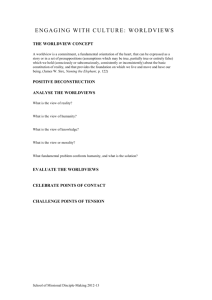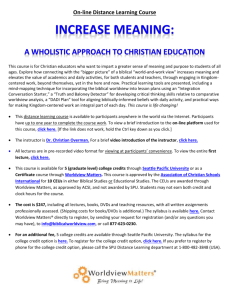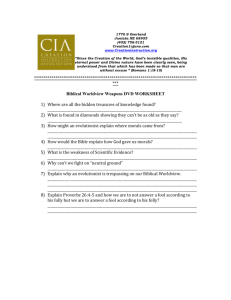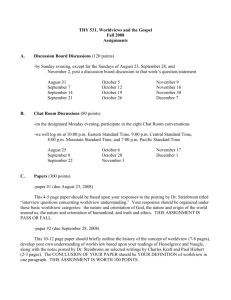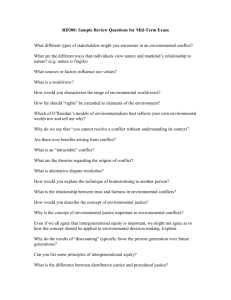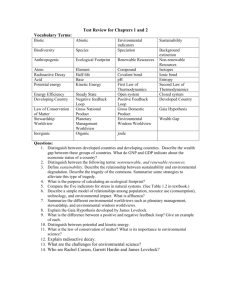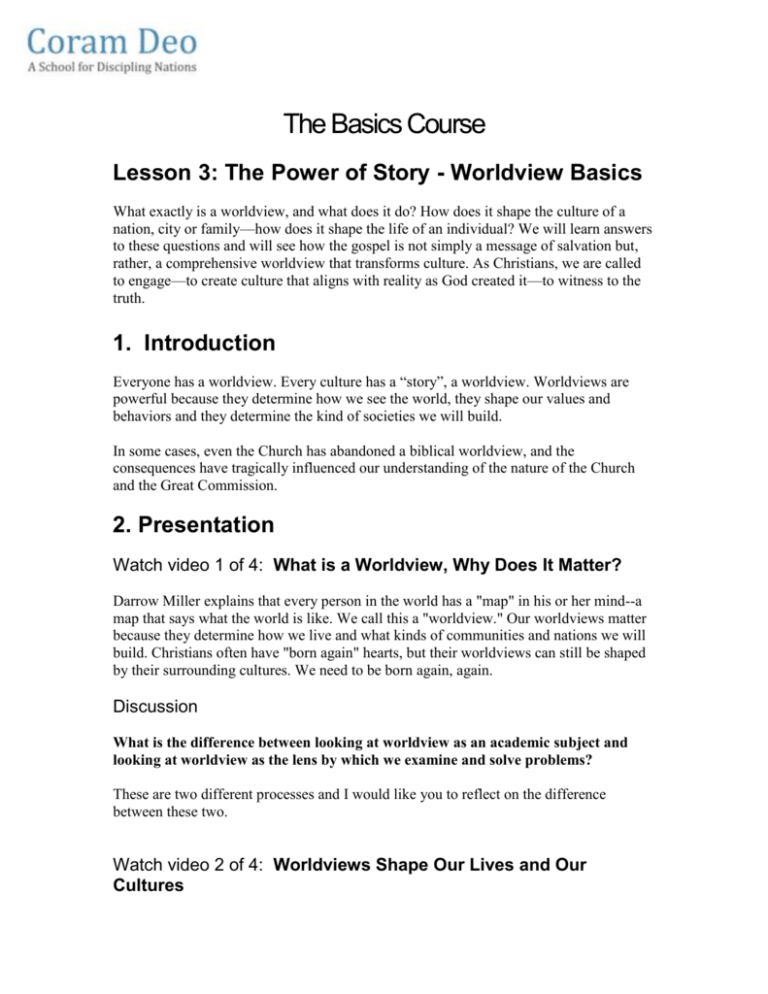
The Basics Course
Lesson 3: The Power of Story - Worldview Basics
What exactly is a worldview, and what does it do? How does it shape the culture of a
nation, city or family—how does it shape the life of an individual? We will learn answers
to these questions and will see how the gospel is not simply a message of salvation but,
rather, a comprehensive worldview that transforms culture. As Christians, we are called
to engage—to create culture that aligns with reality as God created it—to witness to the
truth.
1. Introduction
Everyone has a worldview. Every culture has a “story”, a worldview. Worldviews are
powerful because they determine how we see the world, they shape our values and
behaviors and they determine the kind of societies we will build.
In some cases, even the Church has abandoned a biblical worldview, and the
consequences have tragically influenced our understanding of the nature of the Church
and the Great Commission.
2. Presentation
Watch video 1 of 4: What is a Worldview, Why Does It Matter?
Darrow Miller explains that every person in the world has a "map" in his or her mind--a
map that says what the world is like. We call this a "worldview." Our worldviews matter
because they determine how we live and what kinds of communities and nations we will
build. Christians often have "born again" hearts, but their worldviews can still be shaped
by their surrounding cultures. We need to be born again, again.
Discussion
What is the difference between looking at worldview as an academic subject and
looking at worldview as the lens by which we examine and solve problems?
These are two different processes and I would like you to reflect on the difference
between these two.
Watch video 2 of 4: Worldviews Shape Our Lives and Our
Cultures
Darrow Miller explains how our worldviews shape our values and behaviors and how our
behaviors have consequences for our lives, families and society. He describes how
worldviews spread around the world, are transmitted from one generation to the next, and
move vertically through culture. The gospel is not simply a message of salvation; it is a
comprehensive worldview. It must not only move around the world, but it must penetrate
and transform culture. This is what it means to disciple nations.
Discussion
What does it mean for the gospel to penetrate culture?
Watch video 3 of 4: The Role of the Artist in Discipling Nations
Darrow Miller explains how ideas shape culture. The process often begins with a small
group of intellectuals whose ideas are picked up by artists. As they create film and music,
and write stories that embody the new ideas, they shape the professionals in society--the
educators, business leaders, economists, and politicians. At this point, the new ideas
become institutionalized, impacting the lives of everyone in the society. To disciple
nations, the church must understand this process, and encourage Christian artists to play a
prophetic role in shaping their culture.
Discussion
Culture is upstream from economics and politics.
What does this mean for Christians and what are the implications of this as you look
at your own culture and the political and economic processes that are going on
today?
Watch video 4 of 4: The Gospel is to Penetrate and Reform
Culture
Darrow Miller explains that evangelism and gospel proclamation are not the end goals of
the Great Commission but rather the vital first steps in discipling nations. The goal is
reformed cultures that reflect God's glory. Darrow explains that our cultures are a
reflection of the God, or gods, that we worship. He then turns to John 17:15-19 to show
that Christ is calling the Church to intentionally work to impact culture.
Discussion
I’d like you to reflect on these three different types of churches:
-
the church that is withdrawn from society
the church that is conforming to society, and
the church that is consciously seeking to impact society, that is engaging culture
outside the walls of the building.
Which is your church?
3. Reading – see end of document
Worldviews at Work in the World
Darrow L. Miller, Bob Moffitt, and Scott D. Allen
4. Application
Think of an example of a "worldview" story accepted by your community that
contributes to poverty. Share your thoughts on this with another person, and hear his/her
thoughts on it as well.
5. Quiz
This 10-question quiz will help you review the key ideas from this lesson.
Question 1 of 10
What limited the discovery of Prince Henry the Navigator to discover a sea route to Asia
around Africa?
A Real physical barriers that prevented his ships from sailing further
B The map in their minds
C The physical map that they carried on their ships
D None of the above
Question 2 of 10
Which of the following does our worldview NOT determine?
A How we see the world.
B How we go about solving a math problem.
C The kind of nations we will build.
D What we see, not what there is to be seen.
Question 3 of 10
While there is a wide range of philosophies and religions in the world, they can be
distilled down into one of three basic worldview categories. Which is NOT one of these
categories?
A Animism
B Theism
C Taoism
D Secularism
Question 4 of 10
Which of the following statements is accurate?
A Today, Western nations are predominantly shaped by a secular worldview that
sees reality as ultimately physical.
B Many Asian and African nations are shaped by an animistic worldview that
sees reality as ultimately spiritual.
C The Biblical worldview sees reality as an integrated whole composed of a
spiritual and physical realm. Both are created by God, and both are important and
valuable.
D All of the above
Question 5 of 10
Paul calls Christians to “not be conformed to the world.” How does one avoid being
conformed to the world?
A By not going to movies and doing other worldly things
B By following Christian rules
C By having your mind renewed to conform to the Biblical worldview
D By spending your time in the church, doing church-organized programs and
activities
Question 6 of 10
Which of the following does the tree diagram NOT illustrate?
A Ideas have consequences.
B The roots of the tree will determine the kind of fruit the tree will produce.
C There are shady ideas in the world.
D Ideas are organic by nature, and they impact people and societies.
Question 7 of 10
Darrow taught that worldviews spread in three ways. Which of the following is NOT one
of these ways?
A Inwardly
B Vertically, through layers of society
C Through time, passed from one generation to the next
D Geographically, from one area of the world to another
Question 8 of 10
Which statement is NOT true?
A Culture is upstream from politics and economics.
B Plato said “Give me the songs of the nation and it matters not who writes its
laws.”
C Culture has nothing to do with politics and economics.
D Artists have the opportunity to speak prophetically to culture.
Question 9 of 10
Which statement is true?
A Salvation should be connected to personal and societal transformation.
B Salvation is only personal and spiritual; it has nothing to do with society.
C True revival will lead to reformation.
D Both "A" and "C" are true.
Question 10 of 10
Which is the most accurate description of the church?
A The church is a warehouse for saved souls going to heaven.
B Because the world is so full of evil and sin, Christians are to disengage, get out
of the world, and retreat into the church building.
C Because Jesus wants his people to be in the world, Christians should leave the
church building and become like the world.
D Jesus wants the Church to impact the world; therefore, Christians are to be in
the world, but not like the world. They are to represent the kingdom of God in the
world.
Quiz Complete!
6. Going Deeper
Book – The Worldview of the Kingdom of God by Scott Allen, Darrow Miller and Bob
Moffitt (YWAM Publishing, 2005) is a short, accessible inductive Bible study that serves
as a great starting point for further study.
Book – LifeWork: A Biblical Theology for What You Do Every Day by Darrow Miller
(YWAM Publishing, 2009) is a call for all Christians to deeply integrate the Biblical
worldview into their daily lives and vocations, and in doing so, to fully participate in
discipling our nations.
Book – Pollution and the Death of Man by Francis Schaeffer and Udo Middleman
(Crossway, reprint edition, 2011). In this groundbreaking book, Schaeffer and
Middleman reintroduce the concept and significance of worldview to the church. They
show Christians how the biblical message is comprehensive, including a call for the
church to steward God’s Creation.
Book – Lectures on Calvinism by Abraham Kuyper (Wm. B. Eerdmans, 1943) is a
classic. Kuyper was a great Dutch pastor, theologian, educator and politician who did
more than perhaps any other to develop the idea of a Biblical worldview. The book
contains Kuyper’s famous lecture series at Princeton University in 1898. Also available is
a scan of the 1931 book in PDF.
Book – The Universe Next Door: A Basic Worldview Catalogue by James W. Sire
(InterVarsity, third edition, 1997) is a simple yet comprehensive book on worldview. Sire
develops the basic concept of worldview and examines the worldviews of a number of
modern philosophies and world religions. There are multiple editions and updates of this
popular book available.
Worldviews at Work in the World
Darrow L. Miller, Bob Moffitt, and Scott D. Allen
Josie was a Peace Corps worker and nurse at the Serabu Mission Hospital in Sierra Leone,
a nation on the west coast of Africa. She had just completed teaching a course in
microbiology to ten Sierra Leonean nursing students. All the students had passed their
examinations. In doing so, they had demonstrated an understanding that viruses, bacteria,
and other microscopic organisms cause disease.
After the class discussed the results of the final exam, one student raised her hand and
said, “Miss Josie, I know what you taught us about how white people get sick, but do you
want to know how people really get sick?”
“How?”
“It’s the witches! They are invisible and fly around at night, biting people’s backs!”
Josie later explained, “At that moment, with a heaviness of heart, I realized that—as far
as the Sierra Leonean students were concerned—I didn’t know what I was talking about
when it came to the cause of disease. Their grandmothers had taught them that witches
were real and that microorganisms were what white people believed in.”i
Josie and her nursing students operated from different sets of assumptions regarding the
cause of disease. Each set of assumptions was part of its holder’s worldview, or “belief
system.” Josie believed in a physical cause of disease; her students believed in a spiritual
or supernatural cause. While the manifestation of any particular disease was the same,
Josie and her students had different understandings of its nature and cause. Their
respective beliefs were rooted in different worldviews and created conflicting ideas about
how to cure diseases.
Like Josie and her nursing students, each of us possesses a worldview. This worldview
shapes our choices and how we live. According to scholar Samuel Huntington, “In the
back of our minds are hidden assumptions…that determine how we perceive reality, what
facts we look at, and how we judge their importance and merits.”ii These hidden
assumptions also determine “what we believe is real and true, right and wrong, good and
beautiful.”iii For this reason, understanding our worldview is both practical and important.
Our worldviews literally form who we are. These beliefs are deeply ingrained in our
minds, and unearthing them is not easy. In many instances we remain unconscious of
their existence or influence until alternative views challenge them. Nevertheless, a critical
issue for any follower of Jesus is whether or not his or her worldview is rooted in biblical
truth or if instead the surrounding culture has shaped those beliefs.
In many ways our worldview functions like a pair of eyeglasses for the mind. We wear
them all the time and they shape and color everything we see. They focus our attention
upon certain issues while filtering out others. Josie’s worldview focused her attention on
the physical causes of disease—the microscopic organisms that negatively affect the cell
life of a human body. At the same time, her worldview tended to filter out possible
spiritual causes for disease. Meanwhile, the worldview of her Sierra Leonean nursing
students did the opposite.
As we grow and develop, others impart their assumptions about reality to us. Our beliefs
are shaped by input from parents, friends, teachers, mentors, and role models. The
broader culture we live in also influences our worldview, which we absorb as we go
about our daily lives, from sources like television and radio, what we read, the music we
listen to, and even conversations with others.
The Big Questions of Life
Worldviews are extremely important, partly because they help answer “the big questions
of life.” For example: Does God exist, and if so, what is he like, or are we alone in an
impersonal universe? Are there many gods, and if so, what are they like and how do they
relate to us? Who am I and what is the purpose of my life? How should I understand the
natural world around me? Is there purpose to history, or is it meaningless? Is history
ultimately going somewhere, and if so, where? What happens after I die? Why is there so
much pain and suffering in the world? Interestingly, wherever one travels in the world,
the big questions of life are basically the same. However, the answers vary tremendously.
That is because they are founded upon different assumptions about life.
Ideas Reap Consequences
One of the purposes of this study is to provide you with an opportunity—perhaps for the
first time—to examine your own worldview. Our hope is that you will take off your
worldview glasses, handle them a bit, and examine them carefully. This is a powerful
exercise—one of the most important exercises you can ever do! Your worldview is not
simply a set of ideas floating through your head, with no bearing on the rest of your life.
Rather, your worldview largely determines how you live, how you function within your
family, the role you play in your community, and the type of society and nation you
create with others.
You can compare a worldview to the roots of a fruit tree. We cannot see the roots. They
exist below the ground. Yet they determine the kind of fruit the tree will produce. Jesus
used this analogy to warn us against the teachings of false prophets.
Watch out for false prophets. They come to you in sheep’s clothing, but inwardly
they are ferocious wolves. By their fruit you will recognize them. Do people pick
grapes from thorn bushes, or figs from thistles? Likewise every good tree bears
good fruit, but a bad tree bears bad fruit. A good tree cannot bear bad fruit, and a
bad tree cannot bear good fruit. Every tree that does not bear good fruit is cut
down and thrown into the fire. Thus, by their fruit you will recognize them (italics
added). -- Matthew 7:15-20
Objective truth is recorded in the pages of Scripture and revealed in the created order. Yet
Jesus warns us that lies also exist, and often they are subtle and difficult to detect. They
arrive through “false prophets,” who “come in sheep’s clothing, but inwardly, they are
ferocious wolves.” Jesus also tells us that there is a direct link between false ideas (the
roots) and the result or consequence of these false ideas in everyday life (the fruit). If our
roots are formed according to the truth, the fruit of our lives will reflect that truth and be
good, a positive addition to our world. On the other hand, if our lives are the outgrowth of
roots formed by lies, our fruit can only be more of the same, without worth and fit only to
be discarded.
Just as people who look at a tree do not see the
roots, those who observe our everyday lives and
actions cannot see our worldview. Like the roots
of the fruit tree, our worldview exists below the
surface of our lives. Yet also like the roots of the
fruit tree, our worldview produces fruit that has
the same character as the worldview itself. The
things we value, the decisions we make, and our
daily actions reflect and grow from the
assumptions we hold about the big questions of
life.
In short, our worldview produces a certain kind of
fruit, or consequences, in our everyday lives. A healthy worldview—one based on
biblical truth—produces productive consequences. An unhealthy worldview—one based
on lies—produces destructive consequences. These consequences not only affect our own
lives, but also the lives of the people around us. This is even more reason to examine our
own worldview with care.
According to author and scholar James Sire, “A worldview is a map of reality; and like
any map, it may fit what is actually there, or it may be [very] misleading. The map is not
the world itself of course, only an image of it, more or less accurate in some places,
distorted in others. Still, all of us carry around such a map in our mental makeup and we
act upon it. All our thinking presupposes it. Most of our experience fits into it.”iv
There is only one map that accurately reflects reality as it truly exists. This “map” is the
biblical worldview. The entire world is the Lord’s. He created it all. Loving God with
your entire mind means understanding everything in light of God’s revealed truth in
Scripture. It means “understanding God’s ordinances for all of creation, for the natural
world, for societies, for businesses, for schools, for the government, for science, and for
the arts.”v It means developing a biblical worldview, and this is a rewarding, enriching
journey for a disciple of Christ.
The Impact of Worldviews on Society
In every society there exists a dominant worldview shared by the majority. However, this
doesn’t mean that each person in the society ascribes equally to this dominant worldview.
There are always people who hold minority beliefs. Still, the dominant worldview of a
society tends to wield the most influence in shaping its culture and institutions. It
determines which things the
society does and does not value. It is evident
through the society’s educational, political,
social, religious, legal, and economic
institutions. It also resonates through media and
popular culture.
The dominant worldview of our society
influences us profoundly. Often we do not
realize this until we leave our society and visit
another one. Then we begin to understand—
sometimes with amazement—how strongly we
hold to our society’s dominant worldview.
Worldviews on the Move
Worldviews are constantly on the move. They
spread outward across oceans and around the
world. A classic example is the spread of
Christianity. Jesus commanded his followers to
be “my witnesses in Jerusalem, and in all Judea
and Samaria, and to the ends of the earth” (Acts
1:8). From Jerusalem, Christianity spread to
every continent and nearly every
nation on earth.
Worldviews often originate in the
minds of intellectuals, philosophers,
and theologians. From there, artists
and musicians illustrate them. (It has
been said, if you want to know how
the next generation will live, study
the art and music of today.)
Worldviews then spread to other
educated or professional people,
such as teachers, lawyers, pastors,
journalists, and politicians.
Eventually they can become
“institutionalized” as laws,
governing policies, and educational
curricula. As they continue to
penetrate the culture, they eventually
affect the everyday behavior and
lifestyle of its people.
Worldviews also spread through time,
from one generation to the next.
They pass from parents to children.
In the Old Testament, God instructed
parents of his chosen nation, Israel, to accurately teach his revealed commands and laws
from generation to generation. This would ensure that the true knowledge of God would
not be lost or forgotten (Dt 4:1-10).
A Diversity of Worldviews
Throughout history there has been - and will continue to be - a wide range of worldviews.
In this study we organize this broad range into three general worldview categories.
Theism. Though the word can have other shades of meaning, in
this study it will mean the belief in one God who is the allpowerful creator of the physical universe. According to theism,
reality is comprised of both physical and spiritual reality. The
physical universe exists, but so does God who created and
sustains it, and who has a real existence apart from it. Likewise,
human life is an inseparable combination of a physical body
and a spirit. Theism contrasts with naturalism in that its
proponents believe that God exists. Theism contrasts with
animism in that there is only one all-powerful creator God,
rather than many spirits controlling events. Judaism, Islam, and
Christianity are the three major world religions that subscribe
to this general belief.
Secularism. Secularism (sometimes referred to as naturalism, scientism or materialism)
encompasses a set of beliefs that denies or ignores the
existence of spiritual reality. According to secularism,
the physical universe is all that exists. There is no God,
or gods, and no spirit within human beings. All
phenomena in the world can be explained through the
science-defined “laws” (or principles) governing the
physical universe and chance combinations and
interactions of matter. Today secularism is the
dominant worldview in much of the industrialized West.
It gained supremacy through the widespread acceptance
of British botanist Charles Darwin’s (1809-1882) theory
of natural evolution. Secularism underpins the modern
faiths of scientism and postmodernism.
Animism. Sometimes referred to as pantheism, animism is a set of beliefs that sees the
world as full of (or animated with) spiritual beings. There are
scores of gods, demons, and angels. In fact, according to
animism, ultimate reality is fundamentally spiritual. The line
separating physical and spiritual reality is very weak or nonexistent, with spirits inhabiting rocks, trees, and other elements
of nature. The gods of animism may be expressed as
impersonal forces or as personal, even humanlike, beings.
Their actions are often arbitrary and unpredictable. Animism
underpins many ancient religions such as Shinto in Japan and
Hinduism in India and is still dominant in many less
industrialized societies in Africa, Latin America, and Asia. In
addition, elements of the modern New Age movement in the
West have also adopted some animistic concepts.
While it’s helpful to understand these three worldview categories as distinct from one
another, it’s common for people and societies to combine elements from each. Typically,
one of these categories will be dominant within a culture; however, there will likely be
elements of all three categories evident to some degree. In the industrialized West for
example, naturalism is the dominant worldview, yet Christianity continues to exert an
influence. Likewise, the animistic beliefs espoused by some in the New Age movement
are exerting an increasing influence. In addition, today many Europeans are rediscovering
and worshiping the same pagan gods that their ancient ancestors once worshiped.
Biblical Theism
While there is a diversity of beliefs among the world’s peoples, the Bible declares that
there is only one true reality. If this is the case, then there can be only one worldview that
reflects the truth. The challenge for us is to understand this worldview and order our lives
according to it.
This true worldview—the biblical worldview—is God’s revelation to us in Scripture and
through creation. The Bible teaches that this worldview is actually embedded within the
hearts of all people (Rom 2:14-16), though humanity’s fallen nature diminishes its
presence.
When our minds embrace the biblical worldview, we begin to see the world as it really
is—as God created and sustains it. As we believe and act on this worldview, our lives
manifest healthy, fruitful living. This will be good not only for us but for our families,
communities, and societies as well.
The Bible teaches that human nature is not perfect, but fallen. Because of fallen human
nature, we cannot clearly see true reality without God’s help. Naturalism, animism, and
some forms of theism are distortions of the truth that prevent us from clearly viewing all
of reality. Either they allow us to see a portion of what is real or they distort the portion
that we see. Often, they do both. The biblical worldview, by contrast, allows us to see all
that is real. When we “put on” the biblical worldview we can understand God as he truly
is—and ourselves and creation as we were made to be.
People Perish for Lack of Knowledge
Every Christian engages in a life-long process of putting off a false worldview and
putting on God’s view of the world—the biblical worldview. This renewal of the mind is
central to the process of sanctification. The “putting off” and “putting on” process
requires us to gain deeper understanding of, and live increasingly more consistently with,
the biblical worldview.
It is only to the degree that individuals or societies put off false worldviews and put on
God’s view of the world that they experience life, freedom, and healing as God intends.
False worldviews lead to bondage, impoverishment, corruption, and ultimately death.
There can be nothing more important for the Christian believer than the great quest to
abandon deception and embrace the truth, for in the words pastor and professor Dallas
Willard, “People perish for lack of knowledge, because only knowledge permits assured
access to reality; and reality does not adjust itself to accommodate our false beliefs, errors,
or hesitations in action.”
Willard continues:
We can fail to know because we do not want to know—because what would be
known would require us to believe and act in ways contrary to what we want…
The rejection and the subsequent loss of knowledge once possessed is a curious
and tragic thing to be seen in individual lives and in societies. Whether we have
knowledge and are living according to knowledge is a primary indicator of future
weal or woe.
[In the Old Testament], knowledge of God and his ways was the Israelites’ only essential
resource. Conforming in practice to that knowledge kept them in harmony with the reality
that mattered… [But] where people do not want to know God, he usually allows them to
be without him—at least for a while. When desire conflicts with reality, sooner or later
reality wins. A society is like any living organism; its continued existence depends upon
the correct integration of its parts into a whole. That integration cannot be present if the
society is organized around ignorance and illusion and the moral quality of the citizens
falls below a certain level.
Worldview, simply put, consists of the most general and basic assumptions about what is
real and what is good—including assumptions about who we are and what we should
do…there is nothing more practical than our worldview, for it determines the orientation
of everything else we think and do. Moreover, worldview is unavoidable. Everyone has a
worldview… [It] is a biological necessity for human beings, because we act, whether
consciously or not, with reference to a whole (a “world”). Our “view” of that whole
determines what we shall undertake to deal with or omit in our actions day by day and
hour by hour. It dictates what we will or will not count as resources and recognize as
dangers. It determines our aims and our means, and eventually, the quality of our lives
and the kind of person we will become. Our worldview is simply our overall orientation
in life. You cannot “opt out” of having a worldview. You can only try to have one that
most accords with reality…What is true of individuals in this respect is also true of social
groups and even whole societies or nations. Ones worldview…lies outside our
consciousness in the moment of action, embedded in our body and in its social
environment, including our history, language and culture. It radiates throughout our life
as background assumptions, in thoughts too deep for words.
What we assume to be real and what we assume to be valuable will govern our attitudes
and actions. Period. Because worldview is so influential, it is also dangerous. Worldview
is where we most need to have knowledge.vi
This reading is drawn from content in chapters 1 and 2 of The Worldview of the Kingdom
of God, pp. 15-38.
Copyright © 2005 by Darrow L. Miller, Bob Moffitt, and Scott D. Allen
Published by YWAM Publishing
a ministry of Youth With A Mission
P.O. Box 55787, Seattle, WA 98155-0787
All rights reserved. No part of the book may be reproduced in any form without
permission in writing from the publisher, except in the case of brief quotations in critical
articles or reviews.
i
Josie Kornegay, staff person with YWAM Mercy Ships; interview by Darrow Miller, 1994.
Samuel P. Huntington, The Clash of Civilizations and the Remaking of World Order (New York:
Touchstone, 1996), p. 30.
iii
Charles Colson and Nancy Pearcey, How Now Shall We Live (Wheaton, Ill.: Tyndale House Publishers,
Inc., 1999), p. 13.
iv
James Sire, How to Read Slowly (Wheaton, Ill.: Harold Shaw, 1978), pp. 14-15.
v
Colson and Pearcey, p. 34.
vi
Dallas Willard, Knowing Christ Today: Why We Can Trust Spiritual Knowledge (New York, NY:
HarperCollins, 2009), pp. 39-41.
ii

